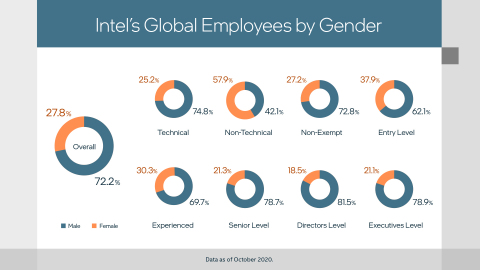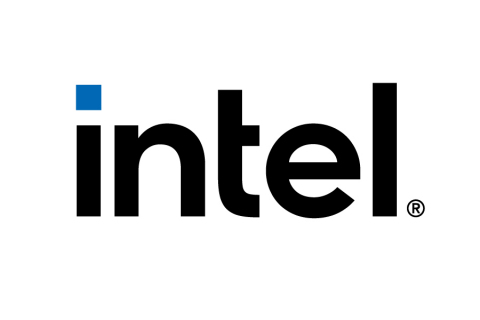SANTA CLARA, Calif.--(BUSINESS WIRE)--The following is an opinion editorial by Dawn Jones, acting chief diversity and inclusion officer at Intel Corporation.
2020 has been a transformative year. It is causing us to think differently about the challenges we face as an industry. Open sharing of our data has enabled Intel to both celebrate progress and confront setbacks. It’s our responsibility to keep raising the bar on transparency for ourselves and the industry.
No matter where we stand today, we must do more – at Intel, but also collectively. As an industry, we are often working in silos rather than collaborating on diversity and inclusion — whether it’s data sharing, culture and policy, innovations and problem solving, particularly as it relates to a small and visible subset of talent.
Today, Intel released its latest representation data and 2019 pay data in EEO-1 format. Although the Equal Employment Opportunity Commission (EEOC) is not requiring employers to file EEO-1 pay data due to the current COVID-19 environment, we felt it was important to not only continue to collect the data, but to disclose it publicly. To make substantial progress, we must be transparent with our data to hold ourselves accountable and encourage industrywide action.
This year, we improved in some areas and declined in others. We progressed globally in our advancement of women in experienced and senior positions and saw significant growth among our Latinx and veteran populations. However, we also saw a decline in our overall U.S. representation of women.
More: 2019 Diversity Report
Our U.S. pay data shows fewer women and underrepresented groups at the company’s most senior levels, and therefore at the most highly compensated levels. White and Asian men make up many of our executive, senior director and manager positions in the highest EEO-1 pay categories, while more women and underrepresented groups hold fewer senior roles and therefore fill lower pay categories.
Over the past decade, Intel has reached full representation in its U.S. workforce for women and underrepresented minorities, two years ahead of schedule. In addition, we’ve achieved global gender pay equity and continued to maintain race/ethnicity pay equity in the U.S., over the past three years. We’ve also met our goal to increase annual spending with diverse suppliers to $1 billion and reached 5 million women through our technology empowerment programs. Data transparency is core to assessing where we still have more work to do.
Our Workforce Data
In this year’s workforce disclosure, we are including underrepresented women data for the first time, along with information about our U.S. veteran population.
Here are our 2019-2020 workforce data key findings:
- In our global workforce, overall women representation improved by a 0.4 percentage point (27.4% to 27.8%) while women in executive-level positions improved by a 0.8 percentage point (20.3% to 21.1%).
- Overall U.S. representation of women declined by a 2 percentage point (26.5% to 26.3%).
- While our global technical women representation improved by a 0.6 percentage point (24.6% to 25.2%), our technical women representation in the U.S. dropped by a 0.2 percentage point (23.7% to 23.5%).
- Overall, underrepresented minority populations improved by a 0.4 percentage point (15.8% to 16.2%), driven mostly by Latinx representation, which was up by a 0.5 percentage point (10.0% to 10.5%). African American representation was flat at 4.9%. Native American representation increased by a 0.01 percentage point (0.79% to 0.8%).
- The U.S. underrepresented minority executive population dropped by a 0.4 percentage point (8.8% to 8.4%), but underrepresented women executives increased by a 0.6 percentage point (1.8% to 2.4%).
- Women comprised about 27% of promotions to vice president, showing an increased attention to progression.
- And since 2017, veteran representation in the U.S. has steadily increased and is up 1.4 percentage points (5.9% to 7.3%).
Raising the Bar over the Next Decade
In support of our RISE 2030 Goals, our diversity and inclusion plans include increasing the number of women in technical roles to 40%, doubling the number of women and underrepresented minorities in senior leadership roles, advancing accessibility and increasing the percentage of employees who self-identify as having a disability to 10% of our workforce, and ensuring inclusive leadership practices are embedded in our global culture. We will also continue to invest in social equity programs and initiatives that advance our inclusion goals.
In 2016, we launched Intel’s Warmline, a confidential online hotline, with the aim of addressing retention issues. Looking to 2021 and beyond, we will add an Executive Warmline that will serve leaders who are directors and above. This will enable us to provide real-time assistance and surface root causes that undermine an inclusive workplace as we continue to focus on retention of women and underrepresented minorities in senior positions.
Addressing Industrywide Challenges
As I said earlier, we must do more as an industry.
A 2017 PayScale study found that compared to white men, white women were 12% less likely to receive a referral, men of color were 26% less likely and women of color were 35% less likely. We need to see and engage the larger talent pool by making our opportunities more visible and accessible to all who are qualified. We also need to create shared metrics and measurements to better evaluate progress.
We are currently working with partner companies to develop a global inclusion index. The purpose of this collaboration is to focus on unified goals and metrics that we can share publicly. We believe efforts like this are the best next steps to address persisting concerns. I look forward to sharing more details about the global inclusion index and our other efforts in the coming months.
Intel is committed to achieving our 2030 goals and advancing diversity and inclusion at every level in our industry. This is foundational to our business and our purpose to create world-changing technology that enriches the lives of every person on Earth. It will require persistence, investment and new kinds of collaboration. We are all in.
About Intel
Intel (Nasdaq: INTC) is an industry leader, creating world-changing technology that enables global progress and enriches lives. Inspired by Moore’s Law, we continuously work to advance the design and manufacturing of semiconductors to help address our customers’ greatest challenges. By embedding intelligence in the cloud, network, edge and every kind of computing device, we unleash the potential of data to transform business and society for the better. To learn more about Intel’s innovations, go to newsroom.intel.com and intel.com.
Underrepresented minority definition: The population of African American, Hispanic, and Native American males and females.
© Intel Corporation. Intel, the Intel logo and other Intel marks are trademarks of Intel Corporation or its subsidiaries. Other names and brands may be claimed as the property of others.




